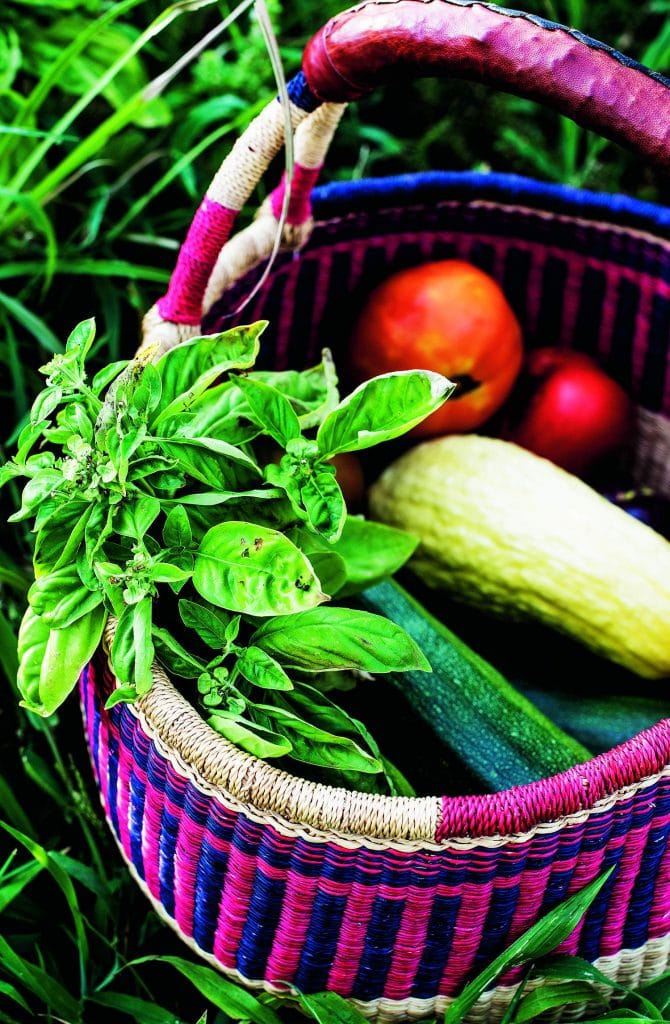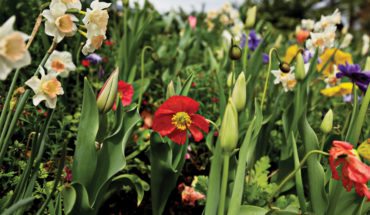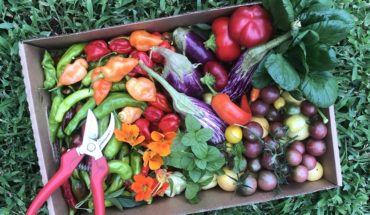Take it easy in summer’s hottest month — use your freezer to preserve tomatoes and plant a few things the get you through the rest of the season.
by Hannah Ross
I wish I could tell you that I thrive in August, the month of my birth, and the month when the tomatoes and peppers I so fiercely covet ripen with abandon. But honestly, the first word I think of when it comes to August gardening is neglect. I struggle to keep up with garden tasks in this steamy month when humidity wilts me. While I try to keep up on the margins of scorching days, there is a definite shift that we gardeners feel at this point in the season, when the momentum of nature’s growth steamrolls us. I bet some of you can relate. If so, consider this column your August garden support group.
Below, I dive into my ideas for tending the garden with an economy of energy, and an appreciation for the gifts of summer without unfair expectations of what we should make of them. First, I’ll offer my favorite shortcuts for summer produce preservation. To follow, you’ll find tips for what to plant this month and how to establish a manageable maintenance schedule in peak summer heat.
LAZY(ISH) PRESERVATION INSPIRATION
Heat gives me a short fuse for tedious tasks like water bath canning. I tend to abandon all canning aspirations when temperatures rise above 95, and seek ways to preserve summer’s bounty without converting my kitchen into a sauna of pickle brine or gelled fruit. Maybe this sounds familiar, or maybe you’re a canning superstar. Either way, you can capture the season’s flavors with less effort.
In summer, the freezer is a trusty ally for quickly preserving seasonal flavor. Devote gallon-sized freezer bags to certain vegetables, adding to your stash each time you harvest or bring home a big market haul. I learned to do this with Thai chiles while working alongside Hmong farmers at a community garden years ago. Raw chili peppers freeze perfectly well, thawing without collapsing the way thicker-walled sweet peppers would. I freeze whole Thai chiles as well as Serrano and Jalapeno peppers, and I’m never without a spicy fix.
While canning, roasting or making sauce from tomatoes is straightforward, freezing whole tomatoes is a brilliant bumper crop strategy, especially for varieties with less juice, like paste or plum tomatoes (as opposed to the giant slicers). Homestead and Chill has a great post on this method. When you’re ready, simply thaw and use frozen tomatoes in soups, stews and sauces of all kinds. For now, they’ll be waiting in the wings rather than on your to-do (or, to-eat) list.
While it does involve turning on the oven, Farmbelly’s cherry tomato confit recipe is a go-to in summer when my vines are loaded. I make big batches almost weekly and fill freezer jars with what I don’t immediately consume; it keeps beautifully for months. And don’t worry— it’s a low and slow roast, so it won’t heat up the kitchen too much!
And although I truthfully detest summer canning, I gather my wits and make it happen once or twice a year, knowing how much I’d regret not making zesty pickles or fig jam. But even then, I seek simple techniques and big flavors. Try this fig jam recipe from Spruce Eats, which calls for a relatively low amount of sugar and no pectin — it couldn’t be simpler. And when the pickle itch strikes, find special recipes unlike the basic slicers available at the store I love Chef Ricky Moore’s pickled okra recipe featured in WALTER’s July 2020 issue.
JUST KEEP GROWING
It might feel like August is where everything green goes to die, but many delicious and lovely plants can be seeded both indoors and out this month, as long as you tend them with care.
The key to August planting is to keep seedbeds and young plants very well watered. Pest pressure is heavy right now, so adding a floating row cover or insect netting can help keep nibbling visitors off of young crops. Keep a close eye on members of the Brassica family like kale and broccoli, which are highly susceptible to chewing insects in late summer.
Goodies to direct seed in August include:
- Beets (keep them well watered)
- Carrots (keep them well watered; afternoon shade helps)
- Sunflowers (flowers will be smaller as days shorten, but still lovely)
- Beans (bush or pole)
- Cucumbers (early August planting yields a quick fall harvest)
- Leafy Asian greens like mustard, mizuna, and tatsoi
- Arugula (although hot weather stokes its spicy flavor)
- Heat tolerant lettuce like Jericho or Salad Bowl (a Google search yields more varieties; provide some shade and water frequently)
- Buckwheat (a quick-growing cover crop that will bloom in just ten weeks— when it does, chop it down in place and let it serve as mulch for fall plantings)
Start seeds indoors now for these fall and winter favorites:
- Kale
- Cabbage
- Broccoli
- Parsley
- Collards
- Snapdragons
- Dianthus
Check your garden center for sales on quick-growing ornamentals to spruce up a tired-looking space. My favorites for high summer planting include:
- Coleus
- Caladium
- Celosia
- Gomphrena
- Ornamental Grasses
GARDEN ON THE MARGINS
The writer Nicole Gulotta speaks of “writing in the margins” in her book Wild Words. As a mother trying to forge a career as a writer, she emphasizes the importance of capturing little moments when they arise— even fifteen minutes while dinner’s in the oven. This concept of capturing the margins instead of letting them slip away (into, say, doom-scrolling through social media) has helped me think more pragmatically about my summer garden. While full weekends of garden work are the bread and butter of my spring and fall seasons, that doesn’t mean yard maintenance needs to look the same in summer. Where are the margins? Where does the work feel lighter, and more joyful?
In summer, enjoying our outdoor spaces is all about timing. During the gentler hours around dawn and dusk, we can accomplish a surprising amount of garden care in short bursts rather than marathon, sunbaked sessions. Dim, cooler hours are also the safest, most effective times of day to water, apply foliar feeds, manage pests and harvest. Find small pockets of time when yard work doesn’t feel like punishment, and make it a date. Use the quiet after-dinner or before-breakfast hour to prune unruly vines, harvest produce, pull weeds, water deeply, seed new crops, monitor for pests or reinforce staked plants with twine. A little each day makes such a difference — and a glass of iced coffee or wine as you work doesn’t hurt!
People say, “everyone should work a service industry job at some point in their life.” I agree. I also think everyone should tend a summer garden or work on a farm in the unrelenting, humid heat of our Southern summers. It is impossible, as the keeper of a garden of any scale, not to be in awe of what farmers consistently provide, despite the unique exhaustion of summer labor. Sweating and swearing as I do through this hobby in summer, I am deeply aware of the privilege of taking breaks, and continually in awe of those who earn a living from the land. What a feat. Thank your farmers!
This article originally appeared on waltermagazine.com on August, 5 2022






Pingback: 20+ Things to Do in Raleigh in August 2022 - WALTER Magazine